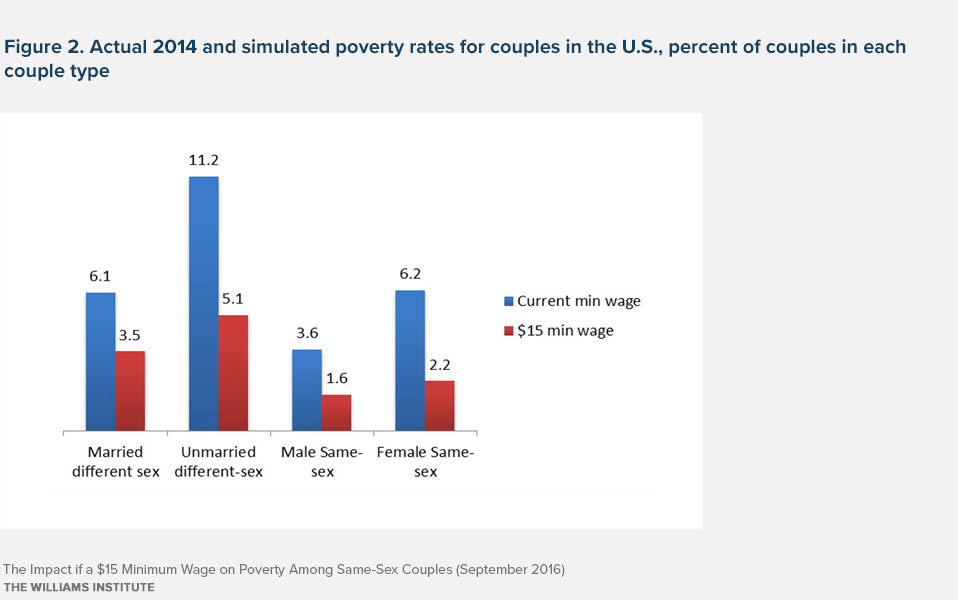Introduction and Summary
Increases in the minimum wage are being proposed, debated, and passed across the United States. In 2016, New York State and California significantly increased their state minimum wage, and the new rate will reach $15 per hour in 2022 in California, $15 per hour in 2018 in New York City, and $12.50 an hour in New York State in 2020. Research in 2014 suggested that increases in the minimum wage could reduce poverty, including poverty among lesbian, gay, bisexual, and transgender (LGBT) people. This research brief predicts that raising the federal minimum wage from its current level of $7.25 to $15 an hour would reduce LGBT poverty by one-third for male same-sex couples and by almost one-half for female same-sex couples. Almost 30,000 people in same-sex couples would see their incomes rise above the federal poverty level.
In 2014, 14.8% of Americans were living on incomes that fell below the federal poverty line, and many LGBT people were also living on poverty-level incomes. Research has shown that LGBT people face a risk of being poor that is at best equal to that of non-LGBT people with similar characteristics and, at worst, much higher than that of non-LGBT people. Lesbians in same-sex couples and African American LGBT people appear to have the greatest vulnerability to poverty.
Methodology
To predict how much LGBT poverty would fall with a higher minimum wage, we update figures from our 2014 study of same-sex couples using the same methodology. We use U.S. data on income and hours worked from the 2014 American Community Survey (ACS) to simulate what happens to families’ incomes if the lowest wage earners see a raise to $15 an hour. The ACS has data on more than 9,000 people in same-sex couples as well as data on married and unmarried different-sex couples that allow us to make comparisons by sexual orientation. We use the official federal definition of poverty, which is having an income that falls below the federal poverty threshold. For example, the poverty line for a two-adult household in 2014 was $15,379 and for a four-person household with two adults and two kids was $24,008.
Actual 2014 and Simulated Poverty Rates for Couples in the U.S.
The blue bars in Figure 1 show that poverty rates for all couples are lower than the national average of 14.5%, which reflects the fact that couples have potentially two incomes for the families to draw on. The patterns across couple type reflect the influence of gender and sexual orientation differences in earnings. For married male-female couples, 5.6% were living below the poverty line in 2014. Female same-sex couples, with the possibility of two incomes subject to the gender wage gap, were more likely to be poor than married different-sex couples, with a 6.9% poverty rate. Male same-sex couples, with the potential for two male incomes, had the lowest poverty rate, at 3.4%. Unmarried different-sex couples had the highest poverty rate at 12.9%, at least in part because they tend to be younger and have less education.


